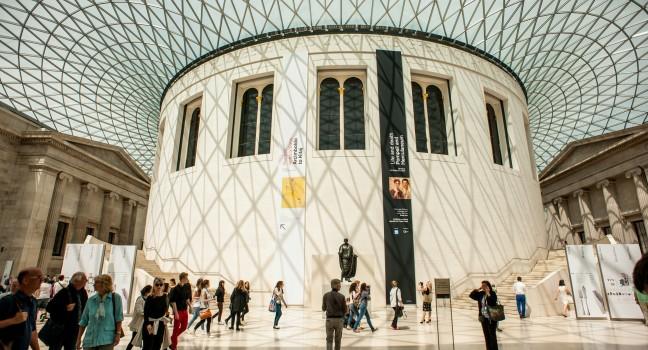Fodor's Expert Review British Museum

The sheer scale and importance of the British Museum's many treasures are impossible to overstate or exaggerate; it truly is one of the world's great repositories of human civilization. Established in 1753 and initially based on the library and "cabinet of curiosities" of the royal physician Sir Hans Sloane, the collection grew exponentially over the following decades, partly due to bequests and acquisitions, but also as a result of plundering by the burgeoning British Empire.
The neoclassical grandeur of the museum's Great Russell Street entrance befits what lies in wait inside. Here you'll find the Rosetta Stone, whose inscriptions were key to deciphering hieroglyphics (Room 4); the controversial but exquisite Elgin Marbles (aka the Parthenon Sculptures) that once stood on the Acropolis in Athens (Room 18); the remarkable 7th century BC masterpieces of Assyrian sculpted reliefs, the lion hunts (Room 10a); and stunning fragments and friezes from the Mausoleum of Halicarnassus... READ MORE
The sheer scale and importance of the British Museum's many treasures are impossible to overstate or exaggerate; it truly is one of the world's great repositories of human civilization. Established in 1753 and initially based on the library and "cabinet of curiosities" of the royal physician Sir Hans Sloane, the collection grew exponentially over the following decades, partly due to bequests and acquisitions, but also as a result of plundering by the burgeoning British Empire.
The neoclassical grandeur of the museum's Great Russell Street entrance befits what lies in wait inside. Here you'll find the Rosetta Stone, whose inscriptions were key to deciphering hieroglyphics (Room 4); the controversial but exquisite Elgin Marbles (aka the Parthenon Sculptures) that once stood on the Acropolis in Athens (Room 18); the remarkable 7th century BC masterpieces of Assyrian sculpted reliefs, the lion hunts (Room 10a); and stunning fragments and friezes from the Mausoleum of Halicarnassus (aka one of the Seven Wonders of the Ancient World; Room 21).
Other perennial favorites include the Egyptian mummies (Rooms 62--63); the colossal Statue of Ramesses II, dating to circa 1270 BC and weighing in at just over 7 tons (Room 4); and the splendid 8th-century Anglo-Saxon Sutton Hoo treasures, with magnificent helmets and jewelry aplenty (Room 41).
Leave time for exploring the glass-covered Great Court, the largest covered public square in Europe, designed by celebrated architect Norman Foster at the turn of the present millennium. Likewise, don't miss the revered circular Reading Room where Karl Marx wrote Das Kapital under the beautiful blue-and-gold papier-mâché dome. And keep an eye out for the museum's excellent temporary exhibitions, which have featured exhibits on Stonehenge and influential Japanese artist Hokusai.
If it all seems a little overwhelming or if you're pushed for time, try one of the excellent museum tours. Eye-opener Tours (free; 40 minutes) offer a choice of 14 individual galleries daily, while the 90-minute Highlights Tour covers all the major exhibits plus a few lesser-known ones, beginning at 11:30 am and 2 pm on Friday and weekends (£14; book online or at the ticket desk in the Great Court). Alternatively, if you have your own headphones, download the museum's app which offers gallery introductions and expert commentaries (from £5).
READ LESS








